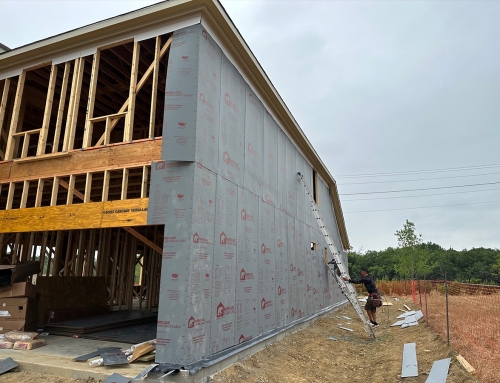A Strong Barrier System Creates an Energy-Efficient, Healthy, and Durable Commercial Building
An effective and strong barrier system around a building’s envelope is critical to the long-term durability and performance of a commercial building. One of the chief challenges of architects and builders in designing and constructing buildings that are vapor-permeable, and moisture- and air-resistant. Foremost, moisture management of a building’s envelope is essential to preventing rot and mold growth.
Moisture management is also critical to creating an energy-efficient building that is comfortable for the occupants. Moisture infiltrates a building envelope through water vapor, liquid water, and air infiltration. Four types of barriers help to prevent moisture accumulation and air- and water infiltration into a wall system: air, vapor, water, and multi-function barriers.
Air Barriers
An exterior wall air barrier stops air leakage and controls air transported moisture through the building’s envelope. The success of an exterior wall air barrier is dependent on professional installation and a whole-building airtightness approach. Proper installation involves following manufacturer guidelines and attention to small details that stop gaps and cracks in the air barrier.
The whole-building airtightness approach addresses the appropriate integration of the air barrier with the windows, doors, curtain walls, roofing, and flooring systems. Importantly, the whole-building air barrier is only as strong as its weakest component. So, details like the securing, cutting, and tapping of the barrier, will affect the air barrier’s performance.
Ultimately, the function of an air barrier is to stop air leakage from the inside to outside of a commercial building and vice versa.
Vapor Barriers and Vapor Retarders
Even with an air barrier, some air, which contains vapor molecules, will enter the wall system, from either the inside or outside of the building. When the air moves through a wall from warm to cool areas, water droplets may accumulate within the wall system. Therefore, it is essential that an airtight wall assembly be moisture vapor permeable so moisture can escape, or diffuse, and not get trapped in the wall.
The goal of a vapor retarder is to retard infiltration of water vapor. There are several classes of vapor retarders. A material’s ability to limit the amount of moisture that passes through it determines the vapor retarder class. The desiccant method of ASTM E 96 is used to determine the vapor retarder (barrier) class:
- Class I is a vapor barrier: 0.1 US Perms or less.
- Class II is a vapor retarder: 0.1 < US Perm <1.0 US Perm.
- Class III is a vapor retarder: 1.0 < US Perm<10 US Perms
The 2018 International Building Code (IBC) 1404.3 and the 2018 International Residential Code(IRC) R702.7 mandate the use of Class I or II vapor retarders on the inside of frame wall in climate zones 5,6,7,8, and Marine 4. Southern Climate Zones 1, 2 and 3 do not require a vapor retarder.
Liquid Water Barrier
Water barriers keep the bulk of liquid water out of the wall system by providing a continuous water-resistant barrier behind the exterior wall siding. Water barriers are also called drainage planes or water-resistive barriers (WRB). Examples of liquid water barriers include house wrap, felt paper, ZIP System® sheathing, delta dry ventilated rainscreen, liquid-applied membrane, and foam board sheathing. The main purpose of these materials is to control liquid water; however, some can also control air flow.
Multifunctional Building Barriers
Vapor-permeable, weather-resistant barriers (WRB) are multi-function barriers that shield the walls of a structure from water and air infiltration, along with moisture accumulation within the wall assembly. High-quality, vapor-permeable WRBs ensure a commercial building is energy-efficient, healthy and comfortable. There are several types of weather-resistant barriers including asphalt-felt, Grade D building paper, and plastic house wrap.
Importantly, a high-quality WRB is always air- and moisture-resistant, permeable, with high tear strength and UV-resistant. It should also be simple to install. In addition, a WRB must meet the 2018 International Building Codes (IBC 1402.2) and the 2018 International Residential Code (IRC R703.1.1) for water-resistance, along with vapor permeability.
Barricade® Building Wrap – a Multi-Function Barrier that Creates an Energy-Efficient, Durable, and Comfortable Building
Barricade Building Wrap is a vapor-permeable weather-resistant barrier that meets and exceeds the requirements of the IBC 1402.2 and IRC R703.1.1. It is air- and moisture-resistant, permeable, UV-resistant, and has high tear strength. Barricade Building Wrap is also simple to install.
- Barricade Building Wraps level of air resistance is high and in accordance with IRC Section N1102.4.1 and IECC Section 402.4 and 502.4.
- Barricade Building Wraps pass all the water-resistant house wrap tests: ASTM D779 (boat test), CCMC 07102 (pond test), and AATCC Test Method 127.
- Barricade Building Wrap is permeable to vapor. The ASTM E96 standard requires house wrap with five perms or greater. The greater the perm, the more permeable the material. Barricade Building Wrap achieves a permeability of 11 US perms (ASTM E-96A).
- The maximum time a house wrap can endure exposure from the sun before becoming damaged is an important element of a house wrap. Barricade Building Wrap can withstand 12 months UV-exposure without damage occurring.
- A WRB with superior resistance to tearing is critical to the successful installation of a weather-resistant barrier. Barricade Building Wrap has a tear-stop design with superb strength (tensile strength (ASTM D-5034) of 63.3 lbs/inch MD, 51.4 lbs/inch CD).
Barricade Wrap is a multi-functioning, effective weather-resistant barrier that creates durable, energy-efficient, and healthy commercial buildings. Please visit Barricade® for more information on building barrier systems that achieve vapor-permeable, and water- and air-resistance.







